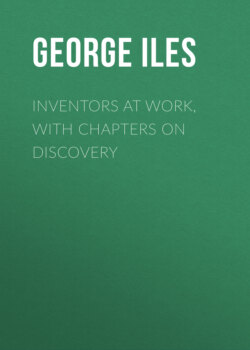Читать книгу Inventors at Work, with Chapters on Discovery - George Iles - Страница 34
На сайте Литреса книга снята с продажи.
Gearing: Conveyors.
ОглавлениеTable of Contents
In the simplest machines motion may be transmitted by wheels in contact, faced with adhesive leather, rubber, or cloth. Teeth, however, are usually employed; as wear takes place they permit a little play, a slight looseness, which contact wheels altogether refuse. Toothed wheels have the further advantage that they do not slip, their motion is positive. How teeth may best be contoured involves nice questions in geometry. They should always push and never grind each other, and should move with the least possible friction. In some ingenious designs the teeth of any one particular wheel of a series will enmesh with the teeth of any other wheel, no matter how much larger or smaller. Bevel gears cut by Mr. Hugo Bilgram, of Philadelphia, turn with hardly any friction whatever, although in some wheels the teeth run askew, or are sections of cones which do not meet at their apices. The Bilgram gear cutter, and the Fellows’ gear shaper which turns out plain gear, exert a to and fro planing action. Ordinary gears are cut on milling machines by rotary cutters, or may be manufactured on a Bliss press without cutting the original lines of fibre. The importance of accurate and easy-running gears increases steadily; they are, for example, applied to steam turbines whose velocity must be reduced in the actuation of ordinary machines. Automobiles and bicycles also demand reducing gear running with the utmost freedom.
Grain elevator.
Robins conveying belt of rubber moved on rollers.
The grain elevator, invented many years ago, is the parent of manifold conveyors of coal, lime, ore or aught else. Their receivers have links shaped so as to extend for hundreds of feet as continuous belts. Link belting may be had in detachable sections, fitting each other at secure hinges which allow free motion.
The Augustin B. Wolvin, a typical ore-carrier on the great lakes, is 56 feet in depth; its hold is curved to allow a clam-shaped bucket to seize ten tons of ore at each dip. It is probable that at no distant day rapid transit in cities will employ continuous moving platforms, just as conveyors and telpherage systems are taking the place of the discontinuous transport of grain, coal, cotton, ore, and heavy merchandise.
Ewart detachable link belting.
